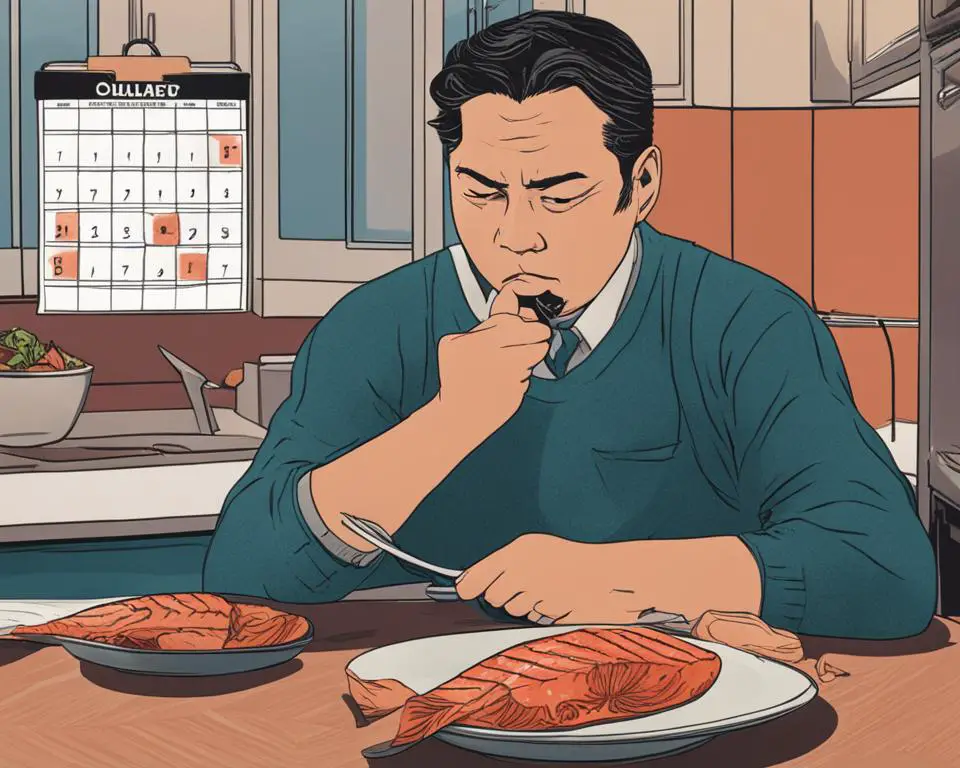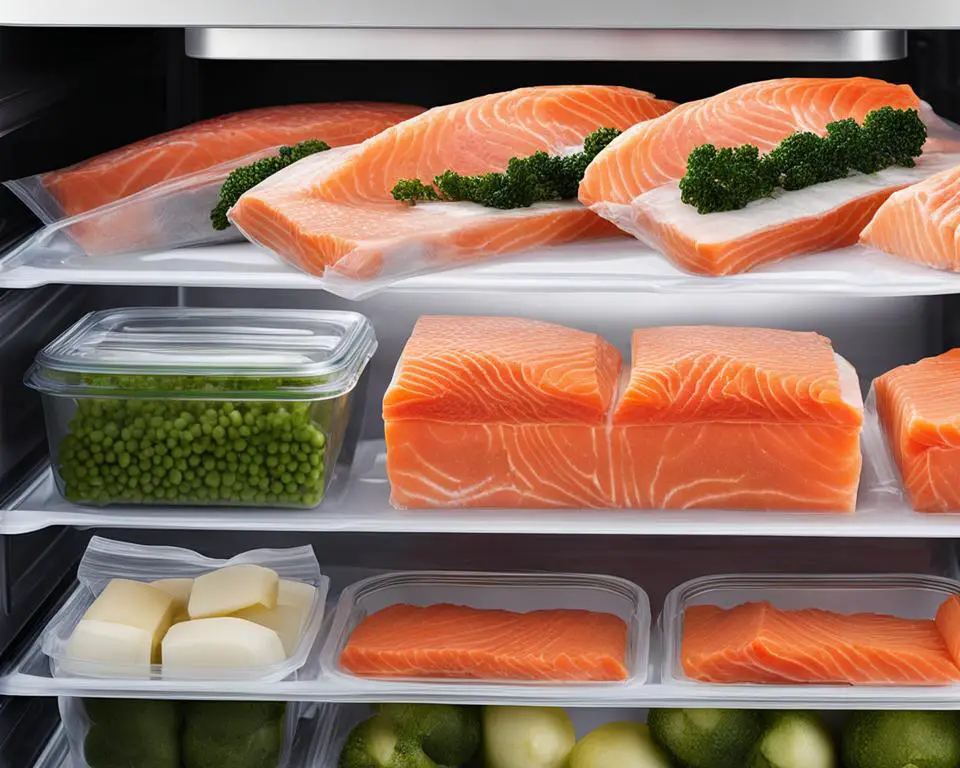Do you have leftover salmon and wondering how to store it properly? Proper storage is essential for maintaining the freshness and safety of salmon for future consumption. Understanding the shelf life of leftover salmon ensures that you consume it when it’s still safe to eat. In this article, we’ll discuss the best practices for storing leftover salmon, extending its shelf life, and the safe timeframe for consuming it.
Whether you’ve made a big batch for meal prep or simply have some leftovers from dinner, storing salmon properly will keep it fresh and delicious for later use. With our useful tips and tricks, you’ll be able to enjoy your favorite fish dish with zero waste. So, let’s dive in and learn how to store leftover salmon for optimal safety and taste longevity.
How Long Does Leftover Salmon Last?
Leftover salmon is a delicious and convenient way to enjoy this nutritious fish for multiple meals. However, it is crucial to be mindful of the time frame for consuming leftover salmon to ensure its freshness and safety.
The shelf life of leftover salmon depends on how it’s stored. Generally, cooked salmon can last for up to three days when refrigerated at a temperature of 40°F or lower. If you decide to freeze it, it can last for up to six months when properly stored in the freezer.
It’s important to note that several factors can influence the shelf life of salmon, such as its initial freshness, cooking method, and storage conditions. Therefore, always use your best judgment when deciding whether leftover salmon is safe to eat. If the salmon smells off or has a slimy texture, it’s best to discard it.
Proper Storage of Leftover Salmon
Storing leftover salmon correctly is crucial in maintaining its freshness and quality. Follow these tips for the best outcome:
- Store the salmon in an airtight container: Place the salmon in an airtight container to prevent the absorption of unwanted odors and flavors from other foods.
- Cover the container with plastic wrap: Before sealing the container with its lid, cover the top with plastic wrap to create an additional layer of protection.
- Store in the fridge: Keep your leftover salmon in the fridge at a temperature of 40°F or below to prevent bacterial growth and spoilage.
- Consume within three days: Consume your leftover salmon within three days to ensure its freshness and prevent any potential health risks.
By following these tips, you can enjoy your leftover salmon without compromising its quality or taste.
Extending the Shelf Life of Leftover Salmon
If you want to preserve your leftover salmon for a longer period, you need to take some extra steps. One effective method is freezing the salmon. Wrap it properly in airtight packaging to avoid freezer burn. Label the packaging with the date you stored it and use it within 2-3 months. You can also try canning leftover salmon for long-term storage. Pressure canning is the most effective method to prevent the growth of bacteria.
To preserve leftover salmon’s taste and quality, consider vacuum sealing it after properly wrapping it. The absence of air helps to maintain the freshness of the salmon. A vacuum sealer properly seals the salmon to prevent any leaks and keeps it fresh for longer periods.
Another option is to use acidic marinades to extend the shelf life of leftover salmon. Marinating salmon in a mixture of vinegar, lemon juice or other acidic ingredients may help to prevent bacterial growth. However, make sure to keep it refrigerated and consume it within a few days.
With these methods, you can extend the shelf life of your leftover salmon while maintaining its taste and freshness. Preserving leftover salmon can help save money and reduce food waste.
Can You Eat Leftover Salmon?
Leftover salmon can be a delicious and convenient option for quick meals, but before consuming it, you may wonder: can you eat leftover salmon?
The answer is yes, you can eat leftover salmon, as long as it has been stored properly and is still within its safe time frame for consumption. However, consuming salmon that has been stored for too long can pose potential risks, such as foodborne illnesses.
It is essential to understand the potential danger of consuming leftover salmon that has gone bad. When salmon is not stored correctly or is past its safe consumption date, it can develop harmful bacteria that may cause food poisoning or other illnesses.
To ensure the safety of your meals, always check for signs of spoilage, such as a foul odor or slimy texture, before consuming leftover salmon. If you detect any signs that the salmon has gone bad or is unsafe to eat, do not consume it.
When it comes to leftover salmon, it’s better to be safe than sorry. Follow proper storage practices and adhere to the recommended safe consumption time frame to ensure a delicious and healthy meal.

Safe Time Frame for Leftover Salmon Consumption
Leftover salmon is a delicious and convenient meal option, but it’s essential to consume it within a safe time frame to avoid the risk of foodborne illnesses. The recommended time frame for consuming leftover salmon is 2-3 days when stored properly in the refrigerator.
However, if you’re unable to consume your leftover salmon within this time frame, you can safely freeze it for up to 2-3 months. Just be sure to wrap it tightly in plastic wrap or aluminum foil and label it with the date before placing it in the freezer.
In summary, it’s crucial to understand the safe time frame for leftover salmon consumption to ensure its freshness and safety. Proper storage and labeling can also help to extend its shelf life, allowing you to enjoy this flavorful dish for longer periods.
Methods of Preserving Leftover Salmon
Preserving leftover salmon can be a challenging task, but with the right techniques, you can effectively extend its shelf life. One popular method is freezing, which involves placing the salmon in an airtight container and storing it in the freezer. To maintain its freshness, make sure to remove any excess air from the container before freezing. Another option is canning, which involves packing the salmon into glass jars and immersing them in boiling water until they are fully cooked. This method can help preserve the salmon for several months.
Additionally, vacuum sealing is an excellent method to preserve leftover salmon. Vacuum sealing removes the air from the container, creating an airtight seal that protects the salmon from exposure to bacteria or spoilage. Another effective technique is pickling, which involves marinating the salmon in vinegar and spices. Not only does this method help preserve the fish, but it also gives it a unique and flavorful taste.
When preserving leftover salmon, it’s essential to label the container or jar with the date and type of fish to ensure you keep track of its freshness. It’s also crucial to thaw the salmon thoroughly before cooking or consuming it. By utilizing these various methods of preserving leftover salmon, you can not only prevent food waste, but you can also enjoy fresh and delicious salmon dishes whenever you want.

Storing Leftover Salmon: Tips and Tricks
Proper storage of leftover salmon can help maintain its quality and freshness. Here are some tips and tricks to ensure that your leftover salmon stays safe to eat.
1. Proper Packaging
Use airtight containers or freezer bags to store leftover salmon. This helps to prevent air exposure and keeps the salmon fresh for a longer time. Before storing, pat the salmon dry with a paper towel to remove any excess moisture.
2. Labeling
Always label your containers and bags with the date you stored the salmon. This helps you to keep track of the storage time and ensures that you consume the salmon within the recommended time frame.
3. Utilize Different Storage Containers
You can use different storage containers to maintain the flavor and quality of leftover salmon. For example, store smaller portions in ice cube trays or muffin pans and freeze them. Once the pieces are frozen, transfer them to a freezer bag. This technique is useful, especially if you want to use small amounts of salmon in a recipe without thawing a large portion.
By following these tips, you can store leftover salmon properly and prolong its shelf life while still maintaining its flavor and quality.
Conclusion
Proper storage and understanding the shelf life of leftover salmon are crucial for maintaining freshness and safety in your meals. Always consume leftover salmon within the recommended time frame and make use of effective preservation methods to extend its shelf life.
Remember to utilize handy tips and tricks for storing leftover salmon, such as proper packaging and labeling. By following these best practices, you can enjoy delicious and healthy leftover salmon dishes for longer periods without compromising taste or safety.
Take the time to implement these strategies, and you’ll never have to worry about spoilage or waste again. Enjoy your leftover salmon dishes with confidence and peace of mind!
FAQ
How long does leftover salmon last?
Leftover salmon can typically be safely consumed within 3-4 days if stored properly in the refrigerator.
What is the shelf life of leftover salmon?
The shelf life of leftover salmon depends on various factors, but when refrigerated at or below 40°F (4°C), it is generally safe to eat for up to 4 days.
How should I store leftover salmon?
To store leftover salmon, wrap it tightly in plastic wrap or place it in an airtight container. Make sure it is stored in the coldest part of your refrigerator.
Are there any tips for storing leftover salmon?
Yes, here are a few tips for storing leftover salmon:
– Remove any toppings or sauces before storage.
– Pack it separately from other foods to prevent cross-contamination.
– Label the container with the date when you stored it.
Can you eat leftover salmon?
Yes, leftover salmon can be eaten, as long as it has been stored properly and consumed within the recommended time frame.
What are the potential risks of consuming leftover salmon?
Consuming leftover salmon that has been stored for too long can lead to foodborne illnesses and other health risks. It is important to follow proper storage guidelines and consume it within the safe time frame.
What is the safe time frame for leftover salmon consumption?
Leftover salmon should be consumed within 3-4 days if stored properly in the refrigerator. If it smells or looks off, it is best to discard it.
How can leftover salmon be preserved?
Leftover salmon can be preserved by freezing it or using other preservation methods such as canning or vacuum sealing. These methods help extend its shelf life and maintain its quality.
Are there any tips and tricks for storing leftover salmon?
Yes, here are a few tips:
– Freeze leftover salmon in individual portions for easy thawing and consumption.
– Use freezer-safe containers or bags to prevent freezer burn.
– Properly label the containers with the date of storage.